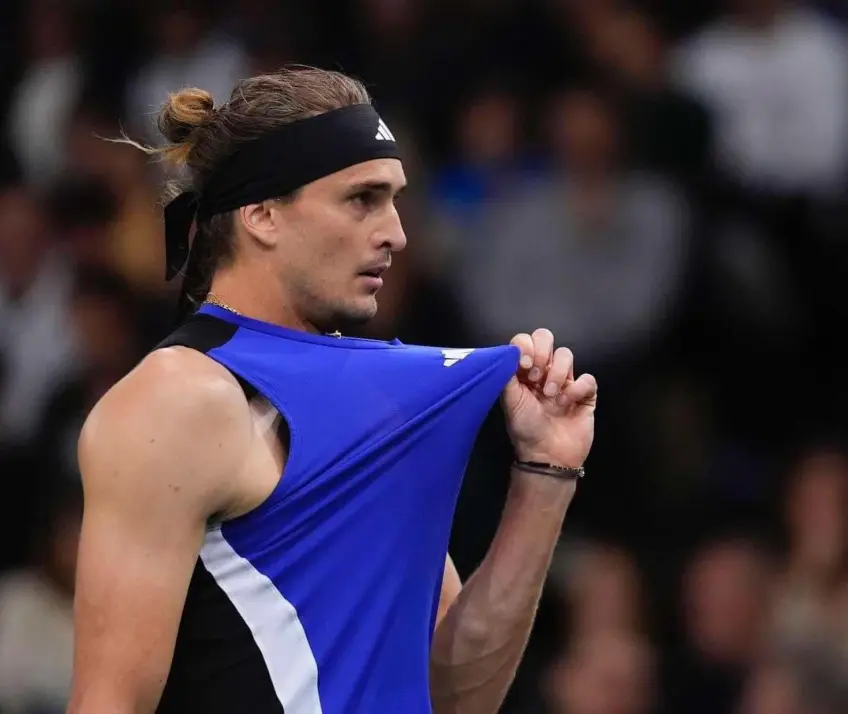
Alexander Zverev has reaffirmed his excellent physical condition as the 2024 tennis season nears its conclusion, even as exhaustion has taken its toll on many of his competitors. The German star’s journey back to top form wasn’t without hurdles; a bout of pneumonia disrupted his performance during the Rolex Shanghai Masters and later the Vienna ATP 500, temporarily stalling his momentum. However, the former world No. 2 displayed remarkable resilience, bouncing back to play some of his finest tennis at the Rolex Paris Masters, where he secured the title with a dominant performance, reinforcing his confidence for the closing stages of the ATP season.
Zverev has consistently proven his mettle at the Nitto ATP Finals, a tournament he has previously conquered twice—once in London in 2018 and again in Turin in 2021. This year, his campaign began on a strong note, as he dispatched formidable rivals Andrey Rublev and Casper Ruud without conceding a set. Despite these wins, Zverev’s place in the semifinals remains undecided. To advance, he needs to take just one set off Carlos Alcaraz during their final group-stage match on Friday. Zverev has expressed his appreciation for the court surface in Turin, noting how it accentuates his strengths, particularly his powerful baseline game and exceptional serve. Given his current form, many believe he is the second favorite to capture the title, trailing only world No. 1 Jannik Sinner, who has also impressed with two victories.
Zverev’s evolution as a player is evident. This season, he has altered aspects of his game and training regimen. Unlike in previous years, he has been logging extensive practice hours—even after competitive matches—and has adopted a more aggressive approach on the court. This strategy has paid dividends, leading to a highly consistent season and a rise in the ATP rankings, where he now sits ahead of Carlos Alcaraz, despite the young Spaniard’s triumphs in two Grand Slam events this year. However, Zverev’s critics point to a tendency to adopt a passive stance during crucial moments in Grand Slam tournaments, a flaw that has proven costly in pivotal matches.
Reflecting on his win over Casper Ruud, Zverev commented, “It was a good match. I think both of us played quite well. I’m pleased with the victory. Maybe this match was even better than the first, despite the strong start I had earlier. I’m excited to face Carlos on Friday and hopefully continue this momentum through the weekend.” With a record of 16 wins and 9 losses at the ATP Finals, Zverev jokingly attributed his statistics to his age, adding, “It means I’m old! But I don’t feel that way. I believe I have another solid decade ahead of me. Tennis is evolving with younger players emerging, and it’s great for the sport. Fans are enjoying the new faces and the high energy.”
Zverev’s ambition to secure a Grand Slam title remains a driving force. He is targeting a major victory in 2025, a goal that led him to forgo participation in the 2024 Davis Cup Finals in Malaga. His focus is on a productive off-season, followed by a strong start at the United Cup to prepare for the Australian Open in January.
An intriguing aspect of Zverev’s recent interviews has been his candid thoughts on court surfaces. While he appreciates the playing conditions in Turin, he longs for a greater distinction between different types of courts, as seen in previous eras. “When Roger Federer was active, the courts were much more varied. There were significant differences between clay, outdoor hard courts, and indoor hard courts,” Zverev remarked during a press conference. “I miss that. Indian Wells was slow, while Canada and Shanghai were fast. Now, it feels like the surfaces have become too similar.”
Zverev raises an important point. Over the past two decades, court surfaces have been homogenized, ostensibly to create a level playing field for top competitors throughout the season. This trend coincided with—and perhaps fueled—the dominance of the “Big Three”: Roger Federer, Rafael Nadal, and Novak Djokovic. Their unmatched versatility allowed them to excel on all surfaces, but it may have come at a cost to the sport’s diversity. In earlier eras, players like Pete Sampras struggled on clay due to the stark contrast in playing conditions, a challenge that is largely absent today. The uniformity has arguably limited opportunities for specialists and altered the landscape of professional tennis.
As Zverev continues to refine his game and push for greater accomplishments, his perspectives on tennis’s evolution offer valuable insights. The German star is determined to leave his mark on the sport, adapting both his playstyle and his approach to the changing competitive environment. With an eye on future milestones and a burning desire to capture a Grand Slam, Zverev’s journey is one to watch closely. His perseverance, skill, and ambition are key components of a career that promises to leave a lasting legacy.
Leave a Reply